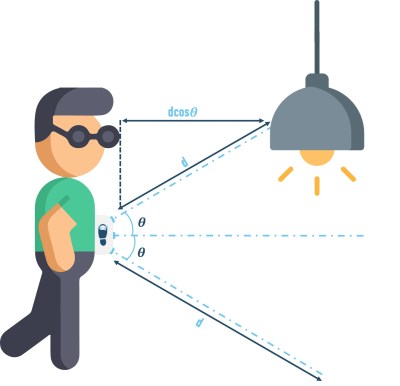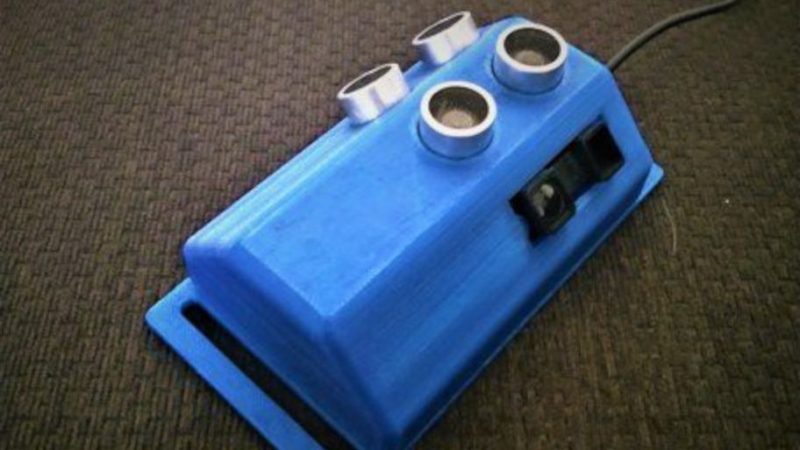For the vision impaired, there are a wide variety of tools and techniques used to navigate around in the real world. Walk-bot is a device that aims to help with this task, using ultrasound to provide a greater sense of obstacles in one’s surroundings.

Created by [Nilay Roy Choudhury], the device is intended to be worn on the waist, and features two sets of ultrasonic sensors. One set is aimed straight ahead, while the other points upwards at an angle of 45 degrees. An infrared sensor then points downward at an angle of 45 degrees, aimed at the ground.
The distance readings from these sensors are then collated by a microcontroller, which uses trigonometry to determine the user’s actual distance to the object. When objects are closer than a given threshold, the device provides feedback to the user via a buzzer and a vibration motor. The combination of three sensors looking out at different angles helps capture a variety of obstacles, whether they be at head, chest, or knee height.
It’s unlikely that a complex electronic device would serve as a direct replacement for solutions like the tried-and-tested cane. However, that’s not to say there isn’t value in such tools, particularly when properly tested and designed to suit user’s needs.
We’ve seen some great projects regarding visual impairment before, like this rig that allows users to fly in a simulator. If you’ve been working on your own accessibility tools, don’t hesitate to drop us a line!
















I started doing something like this for a friend’s blind dog: a collar attachment with an ultrasound transducer and a pager motor. It turned out to be really difficult. A: the dog and their other dog could hear the ultrasound. (That’s fixable by a higher frequency.) B: it was HARD to get something set up that wasn’t repeatedly false triggered by the dog’s other movements, particularly head movements. Before I managed to get it to the point where it was more useful than just annoying, the elderly dog passed away. I still think it’s a worthwhile thing to pursue.
Dog canes (halo around head) seems to be a very effective low-tech solution. Sounds like a better mousetrap problem.
18 months later… I’m looking for a solution for my blind dog. Any chance you want to connect so I can pick your brain on anticipated problems as I try to develop something?
It should problably be possible to do this with an iPhone with lidar, as it “throws” a point cloud in front of it. Not sure if these kind of sensors are also sold on it’s own.
The main problem with this, and countless similar ultrasonic/IR approaches (e.g. gloves, glasses, flashlight-sized staffs, phone apps, etc.), is that the cane isn’t just a tool for the user of it. The cane is a clear indicator to those around the user to give them a wide berth. Obfuscating it defeats a significant part of its job.
A navigational aid that’s barely visible to, say a street full of passing cars, greatly increases the danger to the visually impaired user even if the precision is technically superior to tapping a cane.
Noble intent, of course, and a fine project for learning about sensors and microcontrollers, but it suffers from the common problem in engineering/product design of thinking more about what’s cool to the designer than what’s useful to the user.
Source: I, too, once did a project like this before consulting with any visually impaired people who might use it.
100% in agreement with you on the comment about the designer and the user. This is particularly so in IT, so many developer 12 year old tech nerds with no experience of the real world and ordinary people.
Anyway back to the item, it would be a very welcome augmentatioñ to a white stick and or guide dog, but not a replacement. The more simple and understandable info a user can receive, so much the better.
So crack on with it, make it as unobtrusive as possible and I’m sure it will be a hit.
I agree with what you have said. This article does not completely cover the invention though. If you open the project page, I talk about implementing a gyroscope to know what inclination the device is always at. With such tech onboard, we can find the offset angle from the horizontal and compensate for the change in distances. This will allow the device to be placed anywhere, even on the cane itself!
Everything learned in High School is useful. Just not immediately, and not at the same time.
This guy is great.. Uses mouth Clicks.. I’ve also seen it done with a Hand Held Clicker
https://www.youtube.com/watch?v=ob-P2a6Mrjs
Honestly I think this is the way. A sharp clicker @ 2-10 Hz?, maybe mounted on eyeglasses, and attached to an accelerometer so clicks only happen when the head or body is moving, might be sufficient to give situational awareness, since apparently the brain is able to map spatial awareness from sound reflections onto the visual cortex. It’s definitely a behavior that can be taught and learned. (And there are people born blind who have been doing this since they were kids.)
Human echolocation is covered in Ed Yong’s phenomenal recent book…
In regard to all the comments: Surely there are situations where a cane is a bit cumbersome or tricky I would think.
Canes stick out and can get accidentally poked into things and in small surroundings you’ll knock things over too.
And a cane make a dog think it’s for him to play with :)
And as for clicks, I’d say the audio environment is suitable for that only half the time at best.
Mind you I agree that the final technical solution for this issue is still outstanding, there are many who made this type of echo location boxes with various twists, but it always seem to me too as somehow lacking and more original clever solution has to be devised. I like the combination of sensors and math angle of this iteration though.
I think I’d not go with a vibration motor myself, I think maybe a small servo that pushes a lever against you might be something to give a try, because that seems a more natural ‘obstacle’ feeling somehow.
Some thoughts from someone who born blind and has used a cane for most of her life: One main job of a cane is to show if thingsare NOT there downward staircases, rims of platforms etc. As far as I know none of the sensor devices deals with that. So as far as I know a cane is definitely needed.
I know that some cane designs with sensors and even navigation help exists. (wewalk). THe problem here is, that you can’t the sensors in bad weather, wnen it rains or snows, because they have to be covered to not suffer any damage. So unless the new device can adress both of these problems, it’s not really needed. Or at least doesn’t cover any new ground.